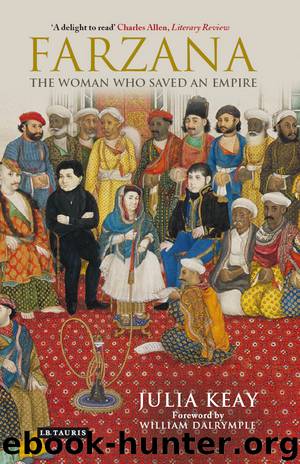Farzana by Julia Keay

Author:Julia Keay [Keay, Julia]
Language: eng
Format: epub
Publisher: I.B.Tauris
Published: 2007-02-15T05:00:00+00:00
9
VIOLENCE, RAPINE AND BARBARITY
The departure for Tappal of Farzana and George Thomas had not left the emperor totally undefended. The gosain Himmat Bahadur was still hanging around Delhi hoping for some recompense for his endeavours at Gokulgarh and had meantime been charged with using his shambolic army of ‘holy men’ to patrol the city walls. More than 2,000 Mughal troops also remained in the city, some of whom were in the pay of the conniving eunuch Mansur Ali. There was too a small detachment of the imperial guard stationed inside the Red Fort to protect the imperial apartments.
Ghulam Qadir and Ismael Beg reached the outskirts of the city at the beginning of July 1788. Since the city gates had been closed on the emperor’s orders, the Rohilla established his camp just outside the walls, while Ismael Beg preferred a site to the south, in and around the magnificent tomb of the thirteenth-century Sufi saint Nizam-ud-din Auliya. Having replenished their supplies by a little local plundering, the two commanders mustered their troops at the city gates and demanded entry. Their demands were rejected and the gates remained closed.
But inside the city Mansur Ali had been scheming on his own account. In pursuit of his long-standing ambition to supplant the Hindu Mahadji Scindia with the Muslim Ghulam Qadir, he had already arranged for 200 ox carts loaded with powder and shot from the stores in the fort to be delivered to his private quarters. Having thus depleted the garrison’s offensive capability, he bribed the sentries to open the city gates and admit the rebels.
From his vantage point among the battlements Himmat Bahadur witnessed the arrival of Ghulam Qadir and Ismael Beg, saw them first being turned away and then admitted, and noted their columns of cavalry and infantry pouring in through the gates. He watched the citizens of Delhi flee in terror at the prospect of yet another round of pillage, rape and murder at the hands of yet another invading army. And because he had no wish to be blamed for the ugly consequences that were sure to follow, the artful gosain decided that this was his moment to leave. By the time the gates had been closed behind the stragglers at the rear of the column, Himmat Bahadur and his ashen cohorts had vanished. ‘This disgraceful and precipitate retreat from his post,’ sniffs Francklin, ‘sullied his reputation as a soldier, and his loyalty as a subject.’1
Of the two rebellious commanders, Ismael Beg was much the less vindictive and erratic. ‘An indefatigable warrior of boundless arrogance, proved valour and high birth’,2 he had accompanied Ghulam Qadir to Delhi for two reasons. The first was his fervent desire, shared with Mansur Ali, to end the domination of the Hindu Marathas and re-establish Muslim control over what little remained of the Mughal Empire. The second was the vast hoard of treasure that according to Ghulam Qadir was hidden somewhere in the imperial palace and to a portion of which Ismael Beg felt he was entitled by way of recompense for his campaigning.
Download
This site does not store any files on its server. We only index and link to content provided by other sites. Please contact the content providers to delete copyright contents if any and email us, we'll remove relevant links or contents immediately.
Fanny Burney by Claire Harman(26507)
Empire of the Sikhs by Patwant Singh(22959)
Out of India by Michael Foss(16776)
Leonardo da Vinci by Walter Isaacson(13145)
Small Great Things by Jodi Picoult(6958)
The Six Wives Of Henry VIII (WOMEN IN HISTORY) by Fraser Antonia(5379)
The Wind in My Hair by Masih Alinejad(5022)
A Higher Loyalty: Truth, Lies, and Leadership by James Comey(4820)
The Lonely City by Olivia Laing(4730)
The Crown by Robert Lacey(4709)
Millionaire: The Philanderer, Gambler, and Duelist Who Invented Modern Finance by Janet Gleeson(4351)
The Iron Duke by The Iron Duke(4270)
Papillon (English) by Henri Charrière(4174)
Sticky Fingers by Joe Hagan(4083)
Joan of Arc by Mary Gordon(4000)
Alive: The Story of the Andes Survivors by Piers Paul Read(3954)
Stalin by Stephen Kotkin(3864)
Aleister Crowley: The Biography by Tobias Churton(3571)
Ants Among Elephants by Sujatha Gidla(3400)
